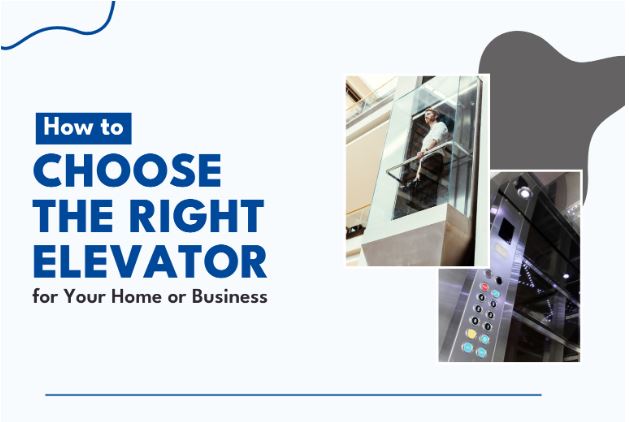Elevators are important in modern life since they provide not only convenience but also necessary accessibility and efficiency for both homes and businesses. Choosing the ideal elevator is an important decision that requires careful consideration of several elements to meet your requirements. This guide simplifies the process of choosing an elevator for your home or company, providing you with the key phases to help you make a wise choice. If you’re considering an elevator installation, selecting the proper one is important for ensuring operation, safety, and cost-effectiveness. Given a variety of lift businesses providing various lift kinds for homes, apartments, and commercial buildings, this blog article will discuss essential elements to assist you in making the best option.
The different factors to consider when choosing an elevator
-
Define Your Purpose:
The first crucial step in choosing the right elevator in Australia is to clearly identify what you’re looking for. This basic choice sets the tone for the whole selection process, directing you towards the elevator type and features that best meet your unique demands. Are you looking for ease in a multi-story Australian home, making everyday mobility between levels easy in a large suburban home or a smaller urban dwelling? Or is accessibility a top priority for your Australian company, with a focus on maintaining compliance with local accessibility rules, such as those modelled after the Australian Disability Discrimination Act (DDA)? In Australia, where legislation and safety requirements vary by area and application, clearly expressing your objective is vital.
It not only determines the intended use of the elevator, but it also impacts design decisions that the specific architectural and environmental factors of Australian structures may impact. Whether you’re looking to improve the comfort of your home in Melbourne or Sydney or ensure equitable access in your business in Brisbane or Perth, this first step ensures that the elevator you select perfectly matches your objectives, providing a seamless and effective vertical transportation solution tailored to the Australian context and regulatory requirements.
-
Installation Budget
When selecting the correct elevator, it is important to consider your budget. In Australia, where financial planning plays an important role in any building or remodelling project, establishing a clear and realistic budget for your elevator installation is necessary. This covers not just the original purchase and installation costs, but also ongoing maintenance, energy use, and future repairs. Elevators are available at a variety of pricing ranges, and recognising your financial limits can help you navigate the many possibilities efficiently. While it may be tempting to choose the most luxurious or feature-rich elevator, it is equally important to ensure that your option fits within your budget without sacrificing safety, compliance, or long-term functioning. By precisely outlining your price ranges, you can make a smart selection that not only satisfies your demands but also assures the financial viability of your elevator project.
-
Type of Elevator
When it comes to vertical transportation, choosing the proper sort of elevator is important, especially in Australia. The diverse landscape of Australia has a wide range of building styles, from family housing in urban and suburban regions to commercial skyscrapers in bustling metropolitan centres. As a result, the sort of elevator you select should be adapted to your individual requirements as well as the nature of your property.
-Hydraulic elevators:
They are ideal for low to mid-rise residential structures because they provide a smooth and quiet trip.
-Traction elevators:
They are efficient and excellent for commercial properties and high-rise structures in Australia’s main cities.
-Pneumatic vacuum elevators:
They are noted for their space-saving features and might be a good fit for modern residences or smaller business buildings.
-Platform or wheelchair lifts:
In Australia, where accessibility is a priority issue, platform or wheelchair lifts can provide cost-effective options for overcoming height differences.
Each elevator type has benefits, and knowing your property’s particular requirements, space limits, and budget can help you choose the best type to guarantee safe and effective elevators.
-
Maintenance and Service
Maintenance and servicing considerations are important in the choosing of an elevator, especially in Australia, where strict safety regulations and operating reliability are important. Elevators, like other machinery, require routine maintenance to ensure that they operate safely and effectively during their lives. A well-defined maintenance plan is a must in Australia, where different climatic variables might impair equipment performance. It is essential to enquire about the maintenance needs and expenses related to the elevator type and brand you have chosen.
Given the large geographical distribution of Australian cities and towns, having access to skilled technicians for periodic inspections and prompt repairs is necessary. Understanding the manufacturer’s warranty and post-installation service packages is also important for ensuring timely and efficient assistance and minimising downtime. Australian legislation frequently requires yearly safety inspections, making it critical to work with a service provider who is familiar with local requirements. Well-planned maintenance not only ensures passenger safety but also extends the elevator’s lifespan and maximises the value of your investment.
-
Capacity and Speed
When selecting the correct elevator, capacity and speed considerations are important, especially in the unique Australian setting where building sizes and occupancy can vary greatly. Elevator capacity should correspond to projected passenger or goods loads, responding to the specific needs of your property, whether it’s a bustling business building in a big metropolis like Sydney or a suburban residence. The pace of the elevator is also important since it affects efficiency and user pleasure. Faster elevators are frequently needed in high-rise buildings to reduce wait times, but somewhat slower speeds may be necessary for comfort and safety reasons in homes or buildings with a variety of tenant demands.
The process of getting an elevator permit
Obtaining an elevator permit in Australia is a detailed and regulated process that ensures safety and compliance with local laws. To get started, you must choose a licenced and experienced elevator installation who will submit complete designs and specifications for evaluation to the appropriate state or area government. Following through to the Building Code of Australia (BCA) plus specific state or territory specifications is required. The authority evaluates the blueprints, performs inspections, and ensures that the installation meets all safety and accessibility standards. Once the installation has been completed, a final inspection is performed, and a permit is granted if everything satisfies the required criteria. After that, the elevator can be put into service, and continuous inspections and maintenance must be performed in according to local requirements to guarantee continued compliance and safety.
Summing Up
Finally, elevators play an important part in modern Australian life, providing convenience, accessibility, and efficiency to both residential and business establishments. Choosing the correct elevator is a complicated procedure. Volkslift, an Australian-licensed elevator firm, provides high-quality elevators and full maintenance services, making them a dependable partner in ensuring continuous safety and efficiency. In Australia, obtaining an elevator permit is a controlled procedure that ensures compliance and adherence to specific rules. By carefully examining these aspects and working with specialists like Volkslift, you can confidently choose the ideal elevator, boosting ease and accessibility while fulfilling the particular requirements of the Australian climate. Elevators are long-term investments, so making an informed decision is important if you want to maximise their advantages in your Australian building.





























